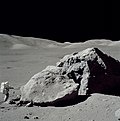The geology of the Moon (sometimes called selenology, although the latter term can refer more generally to "lunar science") is quite different from that...
51 KB (5,981 words) - 06:54, 24 November 2024
The far side of the Moon is the lunar hemisphere that always faces away from Earth, opposite to the near side, because of synchronous rotation in the...
39 KB (4,319 words) - 18:10, 24 November 2024
shared the Earth's composition, including isotopic abundances. The geology of the Moon has since been more independent of the Earth. A 2012 study on the depletion...
30 KB (3,403 words) - 08:22, 7 November 2024
their moons, asteroids, comets, and meteorites. Although the geo- prefix typically indicates topics of or relating to Earth, planetary geology is named...
20 KB (1,136 words) - 07:54, 5 November 2024
Having a mean density of 3,346.4 kg/m3, the Moon is a differentiated body, being composed of a geochemically distinct crust, mantle, and planetary core...
9 KB (1,034 words) - 11:46, 20 October 2024
Apollo 11 (redirect from The Moon Landing)
to understand; lunar geology was too abstract for the average person. Another is that Kennedy's goal of landing humans on the Moon had already been accomplished...
187 KB (19,712 words) - 02:13, 7 November 2024
Moon rock or lunar rock is rock originating from Earth's Moon. This includes lunar material collected during the course of human exploration of the Moon...
34 KB (3,384 words) - 15:06, 19 November 2024
Farouk El-Baz (category Fellows of the Geological Society of America)
responsible for studying the geology of the Moon, the selection of landing sites for the Apollo missions, and the training of astronauts in lunar observations...
19 KB (2,042 words) - 07:17, 28 October 2024
The Moon is Earth's only natural satellite. It orbits at an average distance of 384,400 km (238,900 mi), about 30 times the diameter of Earth. Tidal forces...
267 KB (26,022 words) - 04:13, 23 November 2024
In geology, the crust is the outermost solid shell of a planet, dwarf planet, or natural satellite. It is usually distinguished from the underlying mantle...
11 KB (1,379 words) - 05:24, 25 July 2024
Giant-impact hypothesis (redirect from Moon Formation)
The giant-impact hypothesis, sometimes called the Theia Impact, is an astrogeology hypothesis for the formation of the Moon first proposed in 1946 by...
60 KB (6,880 words) - 14:39, 23 November 2024
Lunar terrane (category Geology of the Moon)
terrane is a major geologic province on the Moon. Three terranes have been identified on the Moon: the Procellarum KREEP Terrane, the Feldspathic Highlands...
11 KB (1,288 words) - 21:08, 28 October 2024
if the summit they reached had been the highest. As a professor at Brown University he published books about the geology of the Moon (Geology of the Moon:...
4 KB (463 words) - 11:38, 31 July 2024
KREEP (category Geology of the Moon)
the longevity and intensity of mare volcanism on the nearside of the Moon. Solar System portal Geology of the Moon Lunar mare Lunar Prospector Moon Lunar...
8 KB (851 words) - 00:09, 11 August 2024
objects Geology of Mercury Geology of Venus – Geological structure and composition of Venus Geology of the Moon – Structure and composition of the Moon Geology...
9 KB (1,305 words) - 16:11, 4 April 2024
chronostratigraphy (the process of relating strata to time) and geochronology (a scientific branch of geology that aims to determine the age of rocks). It is...
174 KB (9,743 words) - 01:50, 14 November 2024
Geology (from Ancient Greek γῆ (gê) 'earth' and λoγία (-logía) 'study of, discourse') is a branch of natural science concerned with the Earth and other...
87 KB (9,649 words) - 03:04, 24 October 2024
Lohrmann (crater) (category Geology of the Moon)
crater that is located to the west of the Oceanus Procellarum, near the western limb of the Moon. It lies to the north of the dark-floored walled plain...
6 KB (363 words) - 09:38, 6 July 2024
directory of lists of geological features on planets excepting Earth, moons and asteroids ordered by increasing distance from the Sun. List of craters on...
4 KB (460 words) - 18:52, 26 December 2023
Lunar magma ocean (category Geology of the Moon)
on the Moon from the time of the Moon's formation (about 4.5 or 4.4 billion years ago) to tens or hundreds of millions of years after that time. The LMO...
18 KB (2,123 words) - 17:41, 9 September 2024
The geology of Triton encompasses the physical characteristics of the surface, internal structure, and geological history of Neptune's largest moon Triton...
39 KB (4,238 words) - 22:25, 31 October 2024
Lunar resources (redirect from Moon mining)
with geologic structures such as lava tubes that, together, might enable lunar habitation. The use of resources on the Moon may provide a means of reducing...
82 KB (8,902 words) - 22:03, 24 September 2024
Magma ocean (category Geology of the Moon)
exists to support the existence of magma oceans on both the Earth and the Moon. Magma oceans may survive for millions to tens of millions of years, interspersed...
10 KB (1,210 words) - 10:02, 7 May 2024
The lunar geological timescale (or selenological timescale) divides the history of Earth's Moon into five generally recognized periods: the Copernican...
13 KB (1,514 words) - 05:54, 24 January 2024
List of Features on Phobos and Deimos may refer to: Phobos (moon)#Named geological features Deimos (moon)#Named geological features This disambiguation...
168 bytes (57 words) - 15:18, 20 December 2019
Quake (natural phenomenon) (category Geology of the Moon)
A quake is the result when the surface of a planet, moon or star begins to shake, usually as the consequence of a sudden release of energy transmitted...
12 KB (1,407 words) - 13:21, 1 November 2024
Impact crater (category Geology of the Moon)
small moons and asteroids. On other planets and moons that experience more active surface geological processes, such as Earth, Venus, Europa, Io, Titan...
44 KB (5,337 words) - 18:26, 18 September 2024
The geology of Mars is the scientific study of the surface, crust, and interior of the planet Mars. It emphasizes the composition, structure, history...
66 KB (7,267 words) - 17:54, 1 October 2024
In geology, rock (or stone) is any naturally occurring solid mass or aggregate of minerals or mineraloid matter. It is categorized by the minerals included...
31 KB (3,305 words) - 14:30, 27 September 2024
Triton is the largest natural satellite of the planet Neptune. It is the only moon of Neptune massive enough to be rounded under its own gravity and hosts...
79 KB (7,911 words) - 21:21, 22 November 2024
























